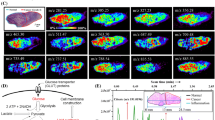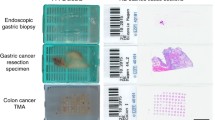Abstract
Liver cancers are characterized by interindividual and intratumoral heterogeneity, which makes early diagnosis and the development of therapies challenging. Desorption electrospray ionization mass spectrometry (DESI-MS) imaging is a potent and sensitive MS ionization technique for direct, unaltered 2D and 3D imaging of metabolites in complex biological samples. Indeed, DESI gently desorbs and ionizes analyte molecules from the sample surface using an electrospray source of highly charged aqueous spray droplets in ambient conditions. DESI-MS imaging of biological samples allows untargeted analysis and characterization of metabolites in liver cancers to identify new biomarkers of malignancy. In this chapter, we described a detailed protocol using liver cancer samples collected and stored for histopathology examination, either as frozen or as formalin-fixed, paraffin-embedded specimens. Such hepatocellular carcinoma samples can be subjected to DESI-MS analyses, illustrating the capacity of spatially resolved metabolomics to distinguish malignant lesions from adjacent normal liver tissue.
Access this chapter
Tax calculation will be finalised at checkout
Purchases are for personal use only
Similar content being viewed by others
References
Godoy-Matos AF, Silva Junior WS, Valerio CM (2020) NAFLD as a continuum: from obesity to metabolic syndrome and diabetes. Diabetol Metab Syndr 12:60. https://doi.org/10.1186/s13098-020-00570-y
Abd El-Kader SM, El-Den Ashmawy EM (2015) Non-alcoholic fatty liver disease: the diagnosis and management. World J Hepatol 7(6):846–858. https://doi.org/10.4254/wjh.v7.i6.846
Dhamija E, Paul SB, Kedia S (2019) Non-alcoholic fatty liver disease associated with hepatocellular carcinoma: an increasing concern. Indian J Med Res 149(1):9–17. https://doi.org/10.4103/ijmr.IJMR_1456_17
Llovet JM et al (2016) Hepatocellular carcinoma. Nat Rev Dis Primers 2:16018. https://doi.org/10.1038/nrdp.2016.18
Farazi PA, DePinho RA (2006) Hepatocellular carcinoma pathogenesis: from genes to environment. Nat Rev Cancer 6(9):674–687. https://doi.org/10.1038/nrc1934
Gong L et al (2019) Cancer cell reprogramming: a promising therapy converting malignancy to benignity. Cancer Commun (Lond) 39(1):48. https://doi.org/10.1186/s40880-019-0393-5
Faubert B, Solmonson A, DeBerardinis RJ (2020) Metabolic reprogramming and cancer progression. Science 368(6487). https://doi.org/10.1126/science.aaw5473
Daniele B, Bencivenga A, Megna AS, Tinessa V (2004) Alpha-fetoprotein and ultrasonography screening for hepatocellular carcinoma. Gastroenterology 127(5 Suppl 1):S108–S112. https://doi.org/10.1053/j.gastro.2004.09.023
Nobuoka D et al (2010) Postoperative serum alpha-fetoprotein level is a useful predictor of recurrence after hepatectomy for hepatocellular carcinoma. Oncol Rep 24(2):521–528. https://doi.org/10.3892/or_00000888
Cillo U et al (2004) The critical issue of hepatocellular carcinoma prognostic classification: which is the best tool available? J Hepatol 40(1):124–131. https://doi.org/10.1016/j.jhep.2003.09.027
Lurje I et al (2019) Treatment strategies for hepatocellular carcinoma (−) a multidisciplinary approach. Int J Mol Sci 20(6). https://doi.org/10.3390/ijms20061465
Gosalia AJ, Martin P, Jones PD (2017) Advances and future directions in the treatment of hepatocellular carcinoma. Gastroenterol Hepatol (N Y) 13(7):398–410
Smith L et al (2020) Important considerations for sample collection in metabolomics studies with a special focus on applications to liver functions. Meta 10(3). https://doi.org/10.3390/metabo10030104
Ferrarini A et al (2019) Metabolomic analysis of liver tissues for characterization of hepatocellular carcinoma. J Proteome Res 18(8):3067–3076. https://doi.org/10.1021/acs.jproteome.9b00185
Feng N et al (2022) Metabolomic biomarkers for hepatocellular carcinoma: a systematic review. Medicine (Baltimore) 101(3):e28510. https://doi.org/10.1097/MD.0000000000028510
Saoi M, Britz-McKibbin P (2021) New advances in tissue metabolomics: a review. Meta 11(10). https://doi.org/10.3390/metabo11100672
Chan LK, Tsui YM, Ho DW, Ng IO (2022) Cellular heterogeneity and plasticity in liver cancer. Semin Cancer Biol 82:134–149. https://doi.org/10.1016/j.semcancer.2021.02.015
Lubin A, Cabooter D, Augustijns P, Cuyckens F (2015) One drop chemical derivatization – DESI-MS analysis for metabolite structure identification. J Mass Spectrom 50(7):871–878. https://doi.org/10.1002/jms.3604
Eberlin LS (2014) DESI-MS imaging of lipids and metabolites from biological samples. Methods Mol Biol 1198:299–311. https://doi.org/10.1007/978-1-4939-1258-2_20
Dannhorn A et al (2020) Universal sample preparation unlocking multimodal molecular tissue imaging. Anal Chem 92(16):11080–11088. https://doi.org/10.1021/acs.analchem.0c00826
Acknowledgments
GK is supported by the Ligue contre le Cancer (équipe labellisée); Agence National de la Recherche (ANR) – Projets blancs; AMMICa US23/CNRS UMS3655; Association pour la recherche sur le cancer (ARC); Cancéropôle Ile-de-France; Fondation pour la Recherche Médicale (FRM); a donation by Elior; Equipex Onco-Pheno-Screen; European Joint Programme on Rare Diseases (EJPRD); Gustave Roussy Odyssea, the European Union Horizon 2020 Projects Oncobiome and CRIMSON (grant agreement No. 101016923); Fondation Carrefour; Institut National du Cancer (INCa); Institut Universitaire de France; LabEx Immuno-Oncology (ANR-18-IDEX-0001); a Cancer Research ASPIRE Award from the Mark Foundation; the RHU Immunolife; Seerave Foundation; SIRIC Stratified Oncology Cell DNA Repair and Tumor Immune Elimination (SOCRATE); and SIRIC Cancer Research and Personalized Medicine (CARPEM). This study contributes to the IdEx Université de Paris ANR-18-IDEX-0001. HC and SL are supported by the China Scholarship Council (CSC, file n°. 201908070134 and file n° 201907060011, respectively). UN-R is supported by Axudas de apoio á etapa de formación posdoutoral da Xunta de Galicia – GAIN. N°Expediente: IN606B-2021/015.
Conflicts of Interest
GK has been holding research contracts with Daiichi Sankyo, Eleor, Kaleido, Lytix Pharma, PharmaMar, Osasuna Therapeutics, Samsara Therapeutics, Sanofi, Sotio, Tollys, Vascage, and Vasculox/Tioma. GK has been consulting for Reithera. GK is on the Board of Directors of the Bristol Myers Squibb Foundation France. GK is a scientific co-founder of everImmune, Osasuna Therapeutics, Samsara Therapeutics, and Therafast Bio. GK is the inventor of patents covering therapeutic targeting of aging, cancer, cystic fibrosis, and metabolic disorders.
Author information
Authors and Affiliations
Corresponding author
Editor information
Editors and Affiliations
Rights and permissions
Copyright information
© 2024 The Author(s), under exclusive license to Springer Science+Business Media, LLC, part of Springer Nature
About this protocol
Cite this protocol
Chen, H. et al. (2024). Biomarker Identification in Liver Cancers Using Desorption Electrospray Ionization Mass Spectrometry (DESI-MS) Imaging: An Approach for Spatially Resolved Metabolomics. In: Kroemer, G., Pol, J., Martins, I. (eds) Liver Carcinogenesis. Methods in Molecular Biology, vol 2769. Humana, New York, NY. https://doi.org/10.1007/978-1-0716-3694-7_15
Download citation
DOI: https://doi.org/10.1007/978-1-0716-3694-7_15
Published:
Publisher Name: Humana, New York, NY
Print ISBN: 978-1-0716-3693-0
Online ISBN: 978-1-0716-3694-7
eBook Packages: Springer Protocols




